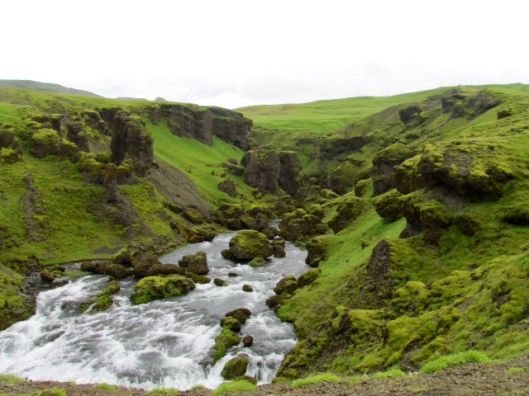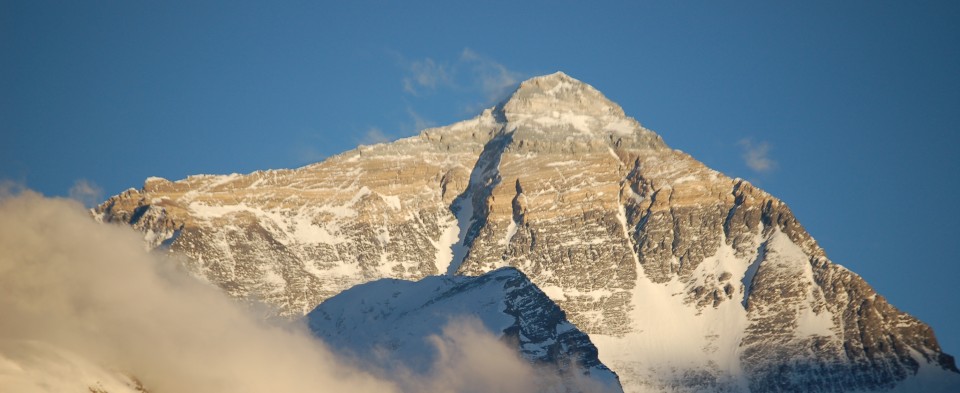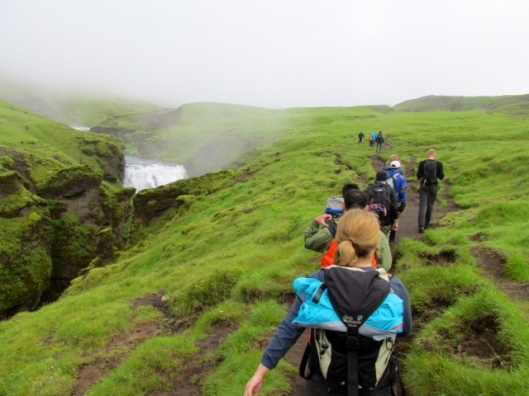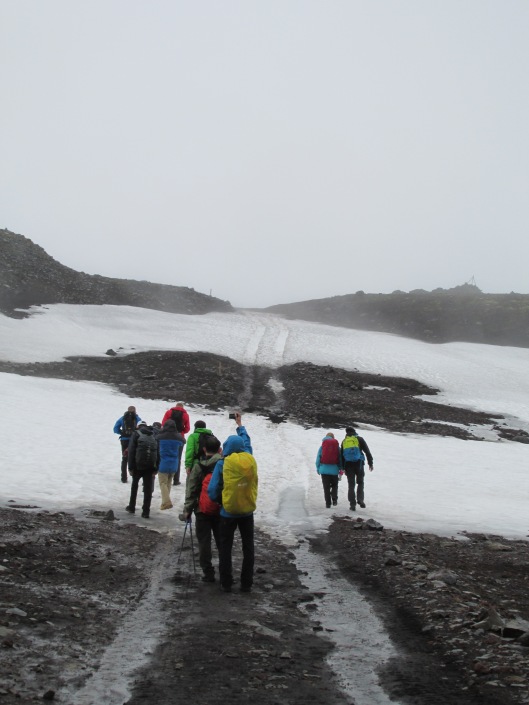Tags
Just a few weeks ago, in a post called “Facing Fears,” I confidently stated that skinny ledges at great heights were not at the top of my fear list. Well, I take that back. But let me start at the beginning.
In the middle of our Iceland trip, my son and I booked a hike with a local mountain guiding company. Sometimes called the Volcano Hike, the 24-km trek follows the Fimmvörðuháls Trail from Skogar to Þórsmörk (Thorsmork) and is a challenging walk anytime, but particularly so on a chilly, rainy day at the very beginning of the hiking season. The trail goes up over the pass between the Eyjafjallajökull and Mýrdalsjökull volcanoes, through the new lava fields from the 2010 eruption of Eyjafjallajökull, and finally down into Thorsmork.
The first several hours were an ascent up past the incredible Skogafoss waterfall and 22 additional falls. Even the rigors of a 2000-foot elevation gain in a few short hours could not diminish the wonder of rounding a bend and discovering yet another thundering gusher amid mossy green hills. This part of the trek was not scary, just a bit tiring climbing high and fast as our guide knew the weather was going to change dramatically and was practically marching us up the mountain in the ever-increasing mist.
After about 2 ½ hours, we reached a rickety old bridge to cross the river we had been following. Here, the landscape began to change and we left the lush green land and rushing river behind. As the trail became dark and rocky, the mist changed to sideways rain. We were told we had finished the hard part and that we had about 4 hours left, meaning we would finish in 6-7 hours what took most people 10 hours to complete. (Some people even do this hike over two days, staying at a hut near the pass.) We were psyched – visions of finishing by 4:30, getting back to Skogar by 6:30, and eating dinner in a warm, dry restaurant instead of on a rock out of our packs sounded great!

After a steady 1000-foot climb, we were on the flanks of a high lava field with theoretically great views of Eyjafjallajökull, the volcano that erupted in 2010 and stopped European air traffic for weeks. Our view, however, was of ever-thickening mist and low clouds, and here we began to cross vast snowfields. Sinking deep and sliding backwards with each step, we slogged for a long time until one of the young men in our group could not continue. His legs were fried, and he had to stop to rest and eat while the rest of us stood in howling winds and sideways sleet, becoming stiffer and colder with every passing moment. Finally, we got moving again and asked how much more snow there would be. “Oh, just a few more minutes until we start to descend.” False. Egregiously false. We continued through that exhausting and freezing snow for nearly two more hours. Our legs were stiff logs, our socks sodden, our feet and toes frozen.
On those compromised legs and feet, we had to pick our way carefully down the next precarious and slippery section, where any false step could mean a fall of several thousand feet. On one steep area, there were chains to hold onto, but the poles into the ground were pulled out! Our guides stationed themselves at both ends of the chains and held on while we went down one by one. At the bottom, there was the tiniest ledge of all, and we had to eventually fit all nine of us on that skinny ledge overlooking a horrifying drop before the guides could rejoin us after holding the chains. Eek!
This ledge is the Heljarkambur ridge that lies near the pass and is a narrow, 50-meter-long traverse with a near-vertical rock face on one side and a steep snowfield dropping off from the other side. Any relief at the end of it was short-lived as we then had to cross the thin pass and begin the descent to Thorsmork along the Kattarhyggir (“Cat’s Spine”) ridge. I have never been so terrified for so long on a trail; my unflappable son said later he was too! I think in good weather these spots would be a bit tricky, but with dead, frozen legs, ice and mud on the ground, and limited visibility, they were truly nerve-wracking.
The rest of the descent was a killer on the knees and quads as we went the remaining 2000 feet down on steep muddy hills. The guide kept saying we had “30-40 minutes” left but it was another two hours until we stumbled into a hut area to await a bus back to our car in Skogar. Still way ahead of the hike time estimate, we discovered we had to wait for the only bus of the day, which was not due to arrive for an hour and a half. (This seems to be a state secret unless you know to check on it; since the trek, we have read over and over how visitors don’t understand that there’s only one way out of Thorsmork, and it’s the 8 pm bus.)
We were soaked to the bone, not a single dry piece of clothing or supplies among us. We shivered and waited and ate the soggy food in our backpacks. The bus finally came and we had a two-hour ride across the eerie, ashy fields between Eyjafjallajökull and Thorsmork – an otherworldly landscape of pure lava and zero sign of life. There were multiple streams of the Krossá River flowing at fast speeds, and we had to repeatedly cross them in the bus. Wheels churning and the bus listing, our vehicle seemed sure to be carried off by the current, but we were so exhausted we could not even focus on how scary it was. We finally made it back to our car in 2 1/2 hours, drove over an hour to our hotel, and arrived there near midnight, still soaking wet.
 The next day, sore and exhausted, we marveled at our feat and laughed only half-jokingly about the PTSD we were suffering. This is a trek we will remember for a long time but, unlike many great hikes of the world, one we have no interest in redoing anytime soon!
The next day, sore and exhausted, we marveled at our feat and laughed only half-jokingly about the PTSD we were suffering. This is a trek we will remember for a long time but, unlike many great hikes of the world, one we have no interest in redoing anytime soon!
A few more photos …











Pingback: A Most Welcome Distraction Today | One Foot Out the Door
I’m sending this post to my travel companion for our upcoming trip to Iceland so we can make an ‘informed opinion’ on whether or not to do this one-day trek 🙂
LikeLiked by 1 person
Great! Glad it might be helpful. In spite of its difficulty, the hike was a great memory and if you are reasonably fit and intrepid, I’d say go for it! At least you will have your expectations in line. We were there almost exactly a year ago, and it was unseasonably snowy then, so with any luck, that challenge will not exist for you. I have a couple of other Iceland posts if you want any other ideas … I’m envious of you getting to go soon! I would absolutely LOVE to go back!
LikeLike
Thank you for sharing! I am going with my young teenagers and husband mid-June this year. We are all fit and love to ramble but not really experienced hikers. That experience would have been quite frightening for me and unpleasant for the rest of us. Unless the weather is perfect, I think we will stick to the hike to and from the bridge or maybe just a bit beyond to experience some of the different conditions without getting into the steeper sections.
LikeLiked by 1 person
That’s a great idea! You might have to hire a private guide (or go it alone) to peel off at that point, but if the weather were as bad as it was for us, this would be a great way to see most of the beautiful parts of the hike without the crazy cat’s spine portions and the lava/snow fields. Have a great time on the trip in general and the hike in particular!
LikeLike
Sounds like a nightmare!
LikeLiked by 1 person
Wellll, yes! But that’s what made it a great memory, too!
LikeLiked by 1 person
i went to Iceland nearly 20 years ago but regret not taking the chance to hike. The weather I remember could change at the drop of a hat. One day I shall go back…
LikeLiked by 1 person
I feel like we all weren’t so focused on hiking back then. Now there are so many companies set up to get us out into the woods and countryside all over the world. In Iceland, that was critical; we would have probably died out there alone! I’d like to go back again, too.
LikeLike
what id really like to do is hire a car for a few weeks there and mix up hiking, camping and hotels/hostels. the hostels were really nice in Iceland.
LikeLiked by 1 person
Spectacular photos and great writing! Thanks for sharing.
LikeLiked by 1 person
Thank YOU for checking it out! I figured after your trip (and spectacular photos), you might want to see what was a little farther along that path! I could go back tomorrow and keep exploring that incredible country.
LikeLike
This looks great! My husband and I are planning a trip to Iceland in early -mid June. What dates did you do this trek? We’ll be there from the 4th to the 16th and are worried it is a little too early for most hiking trails. While, we are both comfortable climbing on snow, we need to know what we may be getting ourselves into, so we are taking precautions and planning carefully.
LikeLiked by 1 person
Hi! Oh, I’m jealous you get to go to Iceland … we enjoyed it so much. I just looked up the date we did this hike, and it was June 17th. So … you may also be looking at one of the first hikes of the season and possible snow up on the top. I’m sure every season is different, but I do know our date was the first regularly scheduled trek for the season that summer. There are still plenty of lower altitude hikes you can do – in Skaftafell, the Snaefellsness peninsula, etc. I have a few other Iceland posts if that is helpful (just put Iceland in the search bar) with your planning. Have fun!
LikeLike
That’s really helpful! Thank you!
LikeLiked by 1 person
We visited in winter when this ‘must do’ hike is no longer doable. Knowing Iceland is a place I will revisit, am bookmarking this, albeit with trembling hands !
LikeLiked by 1 person
I think it would be glorious in full summer. We just hit that trail too early, and we had a guide who was inexperienced. The company was quite apologetic and refunded our fees. We were very lucky no one got lost or frostbitten (not to mention fortunate that no one took a slip off some of the precipices! Yikes, I’m shivering all over again!)
LikeLiked by 1 person
This was one of our FAVORITE countries of all time 🙂 The colors are so outrageous.
LikeLiked by 1 person
Oh, yeah, the colors, the textures, the whole feeling of the place is so unique! We loved it so much. I can’t wait to go someday with my husband. My son has already made it back and found it just as intriguing the second time. This hike was one of the most death-defying I have done, and that was not at all what we were expecting!
LikeLiked by 1 person
Gosh, well done. You’re so brave. But what an amazing place.
LikeLiked by 1 person
Thank you! In many ways I’m really not brave, but I seem to be OK to do certain things that would terrify or worry other people! I also think I get brave in the moment; if I had known about the drop-offs and the weather we’d face on this hike ahead of time, I might not have done it.
LikeLiked by 1 person
Hello! Great photos! I am wondering what guide company you used, I am headed here next month and wanted to do this hike!
LikeLiked by 1 person
Thank you 🙂
LikeLiked by 1 person
Had to go back and look it up … it was Icelandic Mountain Guides. On the whole, I would recommend them, especially when it’s partway into the season and they know what the conditions are like up there. We were flying blind: first day of the season and an inexperienced guide. They were professional dealing with the situation afterward, though. I did lots of research and they seemed to be the ones to choose. Good luck and have fun!
LikeLike